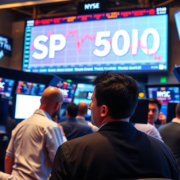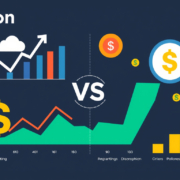China’s Economic Landscape: Slowing GDP, Surging Industrial Output, and Market Resilience Amid Trade Tensions
China GDP Slows While Industrial Output Jumps Following Export Surge; AUD/USD and Hang Seng Index Climb
By Bob Mason | Published October 20, 2025
China shows mixed data. GDP slows and industry climbs. Export numbers rise. This mix lifts market moods. The Australian dollar climbs against the US dollar, and the Hang Seng Index goes up as investors note China’s steady work despite trade challenges with the United States.
Economic Growth Slows Amid Housing Sector Struggles
China’s GDP grew by 4.8% year-on-year in the third quarter. It was 5.2% before. The housing sector faces deep issues. Housing prices fell less in September at 2.2% compared to 2.5% in August. In most cities, prices fall every month. Low prices cut consumer trust and spending. Retail sales jumped only 3% year-on-year in September, down from 3.4% in August.
These housing troubles lead many to doubt Beijing’s work to hit a 5% GDP growth target in 2025. Analysts keep a close eye on the trends.
Industrial Production Rebounds on Export Rise
Industrial output shows strength. It grew by 6.5% year-on-year in September after a 5.2% rise in August. A rise in exports and strong demand abroad back this gain. Though local buying slows, the industry stands firm.
Quarter-on-quarter, GDP stayed at 1.1% in Q3, matching Q2. Strong work in industry kept this pace. More output gave a slight relief to the labor market as the unemployment rate dipped from 5.3% in August to 5.2% in September. There is hope for slow improvements in consumer mood.
Market Reaction: AUD/USD and Hang Seng Index Respond Positively
Good news from industry and overall data helped ease growth fears. On October 20, the Hang Seng Index rose by 2.09% to reach 25,774 amid some ups and downs after the People’s Bank of China did not change loan prime rates. The Hang Seng Mainland Properties Index rose by 0.75%. This rise came as the drop in housing prices slowed.
In the currency market, the Australian dollar edged up against the US dollar. It moved from $0.65049 to a high of $0.65117 and then settled near $0.65103. This near 0.3% jump hints at a mood boost from better export and industry numbers and hints of lessening trade tension before the upcoming APEC meeting.
Broader Implications Ahead of APEC Summit and Policy Developments
These reports come at a busy time as China gets ready for big meetings. The APEC Summit, set for later this month, will see talks between Chinese President Xi Jinping and US President Donald Trump. Markets wait to see if trade talks can cut US tariffs on Chinese goods. Such moves could lift risk views in markets for stocks and money.
At the same time, Beijing’s Fourth Plenum is set to share new policy views. These may include ideas to fix the housing market and boost local buying. Outcomes from this meeting and future GDP goals will shape how investors think about the future.
Conclusion
China’s data gives a mixed view. GDP growth slows as the housing market shows pain and retail sales rise only slightly. Yet, a strong rise in industry backed by export strength gives some hope. The rise in AUD/USD and the Hang Seng Index shows that investors are watching Beijing’s next moves and trade talks to keep growth steady. However, care must be taken as the scene keeps changing.
About the Author
Bob Mason is a financial journalist with over 28 years of experience covering global markets. He writes on currencies, commodities, and stocks in Europe and Asia. His work comes from years with large banks and rating firms.
For updates on market-moving events and economic indicators, please refer to our comprehensive economic calendar.
Full money-growing playbook here:
youtube.com/@the_money_grower








